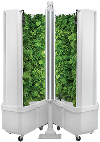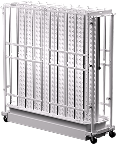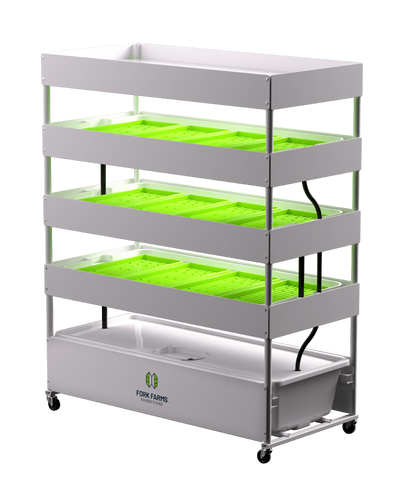7 Common Misconceptions About Indoor Hydroponic Farming
Growing fresh food and plants indoors in a hydroponic farming system has become more popular each year due to the fact that the systems can grow fresh food onsite, sustainably, efficiently, affordably, and all year long. Although indoor hydroponic systems are gaining in popularity, as with anything, many misconceptions about this growing method persist. We’re here to address some of the most common misconceptions regarding indoor hydroponics.
#1 – Growing fresh foods indoors is very hard to do. You need to be an expert farmer and have agriculture experience.
Growing hydroponics indoors is actually quite simple once you have the routine down. You don’t need to be an expert farmer or have a degree in agriculture to set up a hydroponic farm and then maintain it. The most important thing you need is an interest in simply growing foods and plants hydroponically. We know at Fork Farms, that even elementary-age students help grow foods in our Flex Farms. And, what’s more – the students can keep learning about science, agriculture, and sustainability all year long as they watch their farms grow and witness progress firsthand. Watch this video on some of our favorite classroom case studies to learn more.
#2 – An indoor hydroponic farm is very expensive to install, operate and maintain.
Yes, it is true that there can be significant costs associated with the initial installation and setup of a new hydroponic growing system. But, in the long run, well-maintained hydroponic growing systems are typically a sound and fruitful investment that assures long-term high returns. And, as the use of indoor hydroponic growing systems becomes more widespread, systems will become more affordable and more options will be available.
Once the indoor hydroponic farm is up and running, there are many cost-saving benefits to growing hydroponically vs. traditional agriculture since issues with climate change, natural disasters, and pest infestation are eliminated. The hydroponic growing environment is an easier working environment as it is streamlined, consistent, planned, and known. There are no tractors to maintain and there is no soil to tend to. And, with hydroponic farms, you can move quickly to grow new foods to meet consumer demand or to meet your individual needs. This is especially true with green leafy greens that are very easy and fast to grow in the hydroponic environment. Yields and outcomes of fresh foods are highly predictable in a hydroponic environment which translates to high-quality foods, less waste, and ultimately profitability.
Furthermore, there are numerous government grants available to support indoor hydroponic growing all across the country to make this type of farming more attainable to more people.
Regarding the costs associated with maintaining one of our Flex Farms, at the national average of $0.13 per kWh, it costs approximately $20.59 per month in electricity to operate a Flex Farm for the recommended 18 hours per daylight cycle. Other costs include growing supplies such as seeds, nutrients, and Rockwool (grow medium). On average, most of our customers budget about $300 per year to operate and maintain their Flex Farm.
#3 - An indoor hydroponic system takes too much time to set up and maintain.
This one is a big misconception and there are many testimonials that address just this. We can’t speak to other indoor hydroponic farms, but our customers would attest that it typically takes them less than an hour to complete the initial setup and installation of their Flex Farm. On average, our customers then spend about 1 – 3 hours per month maintaining their Flex Farm. This includes the time it takes to plant seeds, transplant seedlings, and harvest the crop. We do know that hours can be spent watching your fresh food grow though!
#4 - An indoor hydroponic farm requires a great deal of space to grow.
Growing food hydroponically requires very little space compared to traditional farming. For example, our Flex Farms need only nine square feet of space to grow 25 pounds of lettuce every 28 days. A Flex Farm is similar in size to a full-sized refrigerator, which can fit in a basement, a garage, a school cafeteria, the lobby of a business, and so on. In traditional farming, plants are spread out, required to search for soil nutrients, and often grow deep roots. Roots take up space and land. In hydroponics, the nutrients are directly supplied to the roots, so there is no need for the plants to search or grow deep roots.
#5 - An indoor hydroponic farm can only grow lettuce.
A wide variety of fresh foods can be grown in an indoor hydroponic farm, not just lettuce. Hydroponic farms incorporate technology that offers the opportunity to grow a variety of foods in the same space at the same time. When planting your first harvest, we do suggest starting with something easy to grow like green leafy greens to get the hang of your system. The Flex Farm is optimized to grow all varieties of leafy greens such as lettuces and culinary herbs. Our partners have also seen success growing cucumbers, strawberries, peppers, tomatoes, and even pumpkins.
#6 - Fruits and vegetables that are grown in indoor hydroponic farms don’t taste as good or have the same nutritional qualities as foods grown in soil.
It’s a known fact that any foods you can get that are fresh and locally grown will taste the best. With hydroponic growing, the nutrient mix can be tailored to meet the specific needs of the plant species, therefore producing crops that can be more nutrient-dense. Since hydroponic fruits and vegetables are grown in protective environments, they suffer less from natural stress factors. This means that they can sometimes contain even more vitamins than soil-grown vegetables at the time of harvest.
#7 - Hydroponic systems use chemicals and food is therefore not organic.
Hydroponic growing uses a nutrient-rich water solution to grow instead of soil. The hydroponic growing environment is controlled from day one, so all nutrients the foods or plants absorb are completely known and regulated. We like to think hydroponic farming is even better than organic farming as it is hyperlocal, controlled and there is no room for error or unknowns. Controlled hydroponic environments also have less exposure to pests and diseases, which in turn decreases pesticide use. As of now, hydroponic produce cannot be labeled organic according to USDA standards, but this could change in time as the hydroponic growing space continues to grow.
Summary
Hydroponic growing can help solve food insecurity and climate change issues. Hydroponic growing can ensure more predictable outcomes in taste and harvest. This translates to long-term, cost-effective, high-quality products that can be sustainably grown. Hydroponics is just one of the many forms of technology and innovation that can enable farms to grow and expand their production. By adopting smart technology and innovative farming features, we can upend today’s food supply chain, and change the way we think about and grow fresh food for all.
If you are curious about hydroponic technology, our team is dedicated to your success. Contact us directly.
Important Links:
























